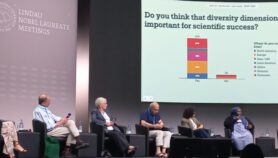By: T.V. Padma
Send to a friend
The details you provide on this page will not be used to send unsolicited email, and will not be sold to a 3rd party. See privacy policy.
[NEW DELHI] Science teaching in Indian schools needs a radical overhaul to stop students losing interest, according to India’s first national science survey.
The findings, released yesterday (28 September) by India’s prime minister Manmohan Singh, also reveals that over 60 percent of science post-graduates are unemployed.
Singh called on the ministry of human resource development to implement the report’s recommendation to strengthen the quality of science teachers, their teaching methods, and the education infrastructure.
The survey, which collected information from 346,000 people in rural and urban areas around the country, was commissioned by the Indian National Science Academy (INSA) and conducted by the National Council of Applied Economic Research (NCAER).
It underlines science education in older children as a major area of concern. Although nearly two-thirds of students in middle school (aged 11-14 years) were satisfied with the quality of science teaching, these numbers dropped to 40 per cent for the 16-18 year-old students.
About one-third of students said they were not motivated enough to continue studying science after leaving school.
India science teachers said they believe few students pursue the subject further because of inadequate practical training and equipment, few job opportunities and the high cost of studying science at university.
The report also shows that numbers of unemployed science graduates has risen, with many others with science degrees opting for non-science jobs.
About 20 per cent of science graduates, 60 percent of postgraduates and 14 per cent of Ph.D. students in science are un employed.
Fewer than four per cent of students said they wanted to become researchers, compared with about 20 per cent who wanted to be engineers, and another 20 per cent doctors.
Another worrying trend is the low number of students who chose to study agricultural sciences at university despite the fact that India’s economy is mostly driven by this sector.
Despite these trends, the survey found 77 per cent of Indians feel science and technology improves the quality of life.
The survey then assessed the scientific understanding of Indians, and compared it with that of Americans. Fifty seven per cent of Indians knew the centre of the earth is very hot, compared with 80 per cent in the United States. Only 38 per cent of Indians answered correctly whether the sex of a baby depends on the father, compared with 65 per cent of Americans.
The report has drawn criticism from some analysts, who say the sampling methods were inadequate and that the results were compared with data obtained using different techniques.
“As a scientist I agree that it would have been better to compare data using the same sampling methodology over, say, three years,” Raghunath Mashelkar, director-general of the Council of Scientific and Industrial Research and current president of INSA, conceded at a press briefing on the occasion of the report’s release.
“They should have had a more rigorous survey methodology,” agrees N. Raghuram, a biotechnology lecturer at Delhi’s Indraprastha University.
“There has been no data about the actual number of science students in schools, teachers, and student-teacher ratio. Even the conclusions on public attitudes towards science are based on a small sub-sample of 30,000 which is not representative enough.”
NCAER project leader Rajesh Shukla, and other scientists have in the past pointed out India does not have a systematic and comprehensive assessment of its science and technology education and industry (see A tale of two databases: India’s R&D dilemma).













